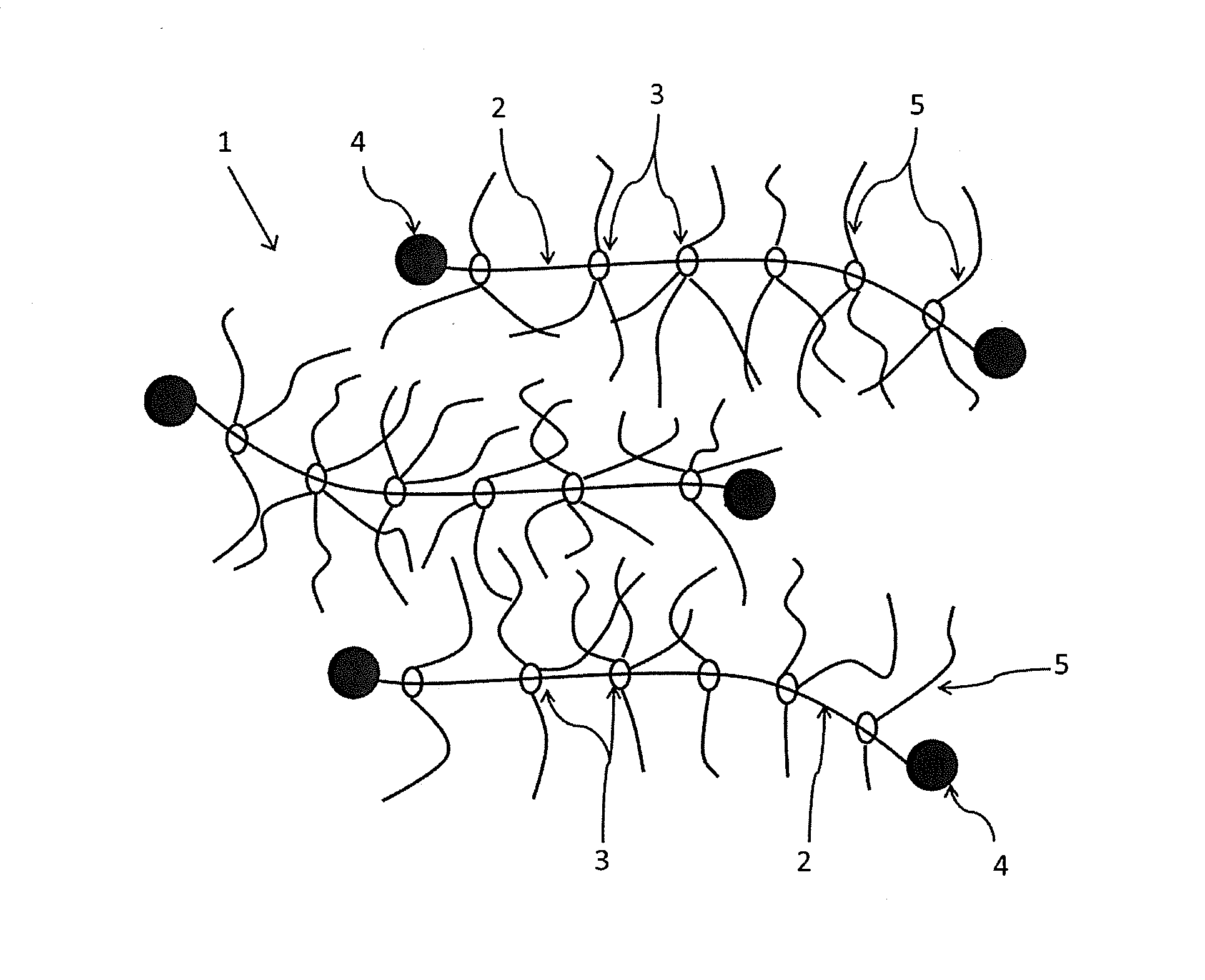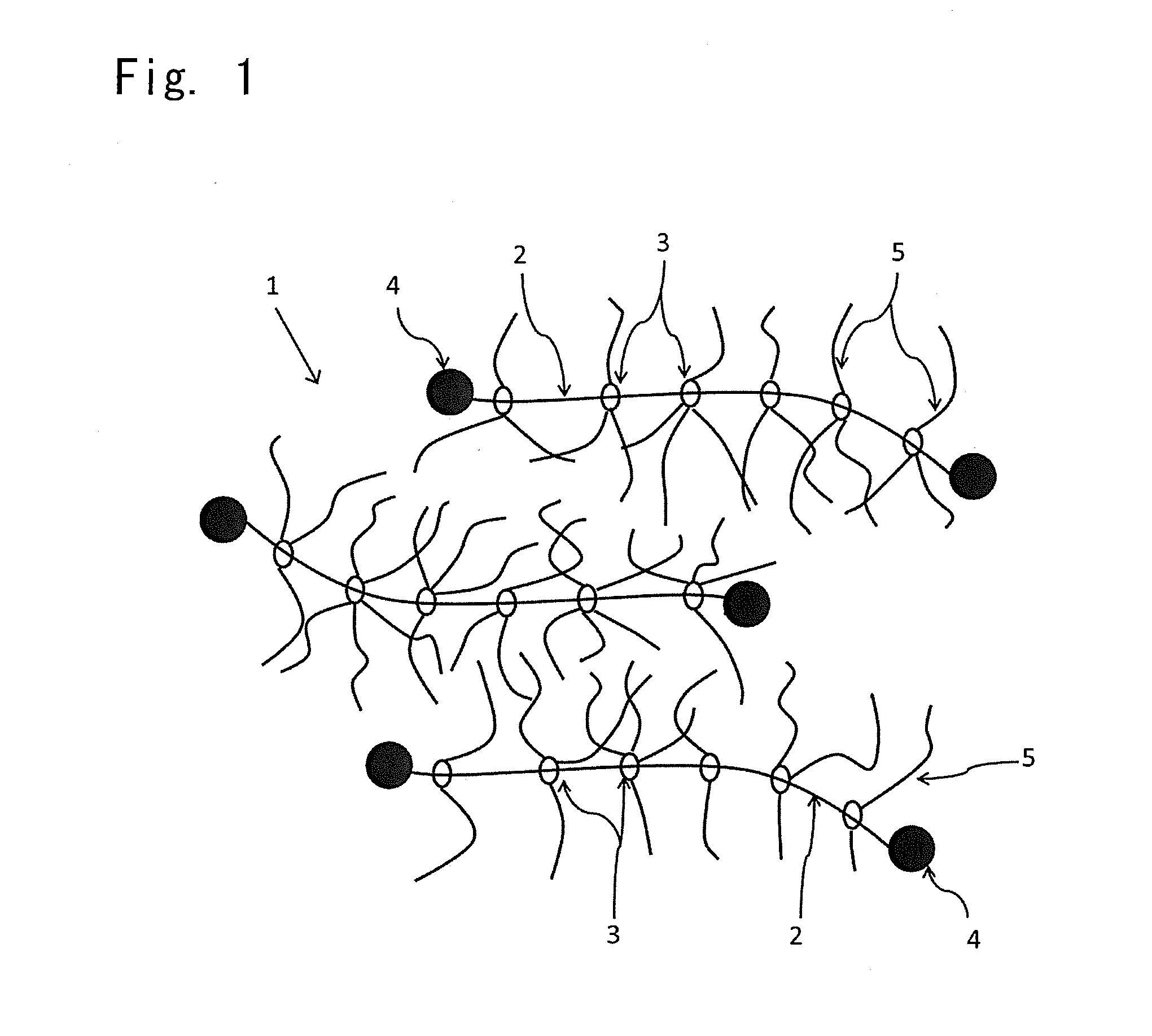Photochromic composition
a composition and photochromic technology, applied in the field of photochromic compositions, can solve the problems of difficult to develop excellent photochromic properties, impaired photochromic reversible reaction, and unsatisfactory photochromic properties of photochromic lenses molded by polymerization cure compositions, etc., to improve color developmentability, improve fading speed, and improve the effect of color developmen
- Summary
- Abstract
- Description
- Claims
- Application Information
AI Technical Summary
Benefits of technology
Problems solved by technology
Method used
Image
Examples
example 1
[0393]10 parts by mass of the polyrotaxane (A-5) and 15 parts by mass of tetrahydrofuran (THF) were stirred and dissolved at 50° C. for 1 hour.
[0394]Then, 0.3 part by mass of PC1 (photochromic compound), 0.03 part by mass of PI (polymerization initiator) and 0.01 part by mass of L1 (leveling agent) were added to and mixed with the resulting solution under agitation at 40° C. for 30 minutes to obtain a photochromic composition. The amounts of these components are shown in Table 1.
[0395]About 2 g of the photochromic composition obtained above was applied to the surface of a glass sheet having a diameter of 80 mm and a thickness of 2 mm with a spin coater (1H-DX2, manufactured by MIKASA) by controlling the revolution speed and time to ensure that the film thickness of the finally obtained photochromic coating film became 40 μm.
[0396]The glass sheet coated with the photochromic composition was exposed to light from a metal halide lamp having an output of 200 mW / cm2 in a nitrogen gas atm...
example 9
[0404]The photochromic composition shown in Table 1 was poured over a glass petri dish having a diameter of about 80 mm to ensure that the thickness of the finally obtained photochromic film became 40 μm. Then, tetrahydrofuran was evaporated from the glass petri dish under vacuum to ensure that air bubbles were not produced in the photochromic film, and finally the film was thermally cured at 100° C. for 3 hours to form a photochromic film. The obtained photochromic film had photochromic properties such as a maximum absorption wavelength of 580 nm, a color optical density of 0.92 and a fading speed of 34 seconds. These evaluations were made in the same manner as in Example 1. The results are shown in Table 2.
example 10
[0405]A photochromic film was formed and evaluated in the same manner as in Example 9 except that the photochromic composition shown in Table 1 was used. The results are shown in Table 2.
TABLE 1Other compounding agents (additives)PolymerizationSolventinitiatorLeveling agentNo.*1*1*2*3(parts by mass)(parts by mass)(parts by mass)Ex. 1A-1(10)A-5(10)PC1(0.3)—THF(15)P1(0.03)L1(0.01)Ex. 2A-2(10)A-6(10)PC1(0.3)—THF(15)P1(0.03)L1(0.01)Ex. 3A-3(10)A-7(10)PC1(0.3)—THF(15)P1(0.03)L1(0.01)Ex. 4A-4(10)A-8(10)PC1(0.3)—THF(15)P1(0.03)L1(0.01)Ex. 5A-1(10)A-5(10)PC1(0.3)—CH2Cl2(15)P1(0.03)L1(0.01)Ex. 6A-2(10)A-6(10)PC1(0.3)—CH2Cl2(15)P1(0.03)L1(0.01)Ex. 7A-1(10)A-5(10)PC1(0.3)—EA(15)P1(0.03)L1(0.01)Ex. 8A-2(10)A-6(10)PC1(0.3)—EA(15)P1(0.03)L1(0.01)Ex. 9A-1(10)A-5(10)PC1(0.3)—THF(15)Perbutyl ND (0.15)—Ex. 10A-2(10)A-6(10)PC1(0.3)—THF(15)Perbutyl ND (0.15)—Comp.—PC1(0.3)4G(10)—P1(0.03)L1(0.01)Ex. 1*1: Component A (parts by mass),*2: Component B (parts by mass),*3: Polymerizable monomer (parts by mass...
PUM
| Property | Measurement | Unit |
|---|---|---|
| Fraction | aaaaa | aaaaa |
| Percent by mass | aaaaa | aaaaa |
| Percent by mass | aaaaa | aaaaa |
Abstract
Description
Claims
Application Information
 Login to View More
Login to View More - R&D
- Intellectual Property
- Life Sciences
- Materials
- Tech Scout
- Unparalleled Data Quality
- Higher Quality Content
- 60% Fewer Hallucinations
Browse by: Latest US Patents, China's latest patents, Technical Efficacy Thesaurus, Application Domain, Technology Topic, Popular Technical Reports.
© 2025 PatSnap. All rights reserved.Legal|Privacy policy|Modern Slavery Act Transparency Statement|Sitemap|About US| Contact US: help@patsnap.com



